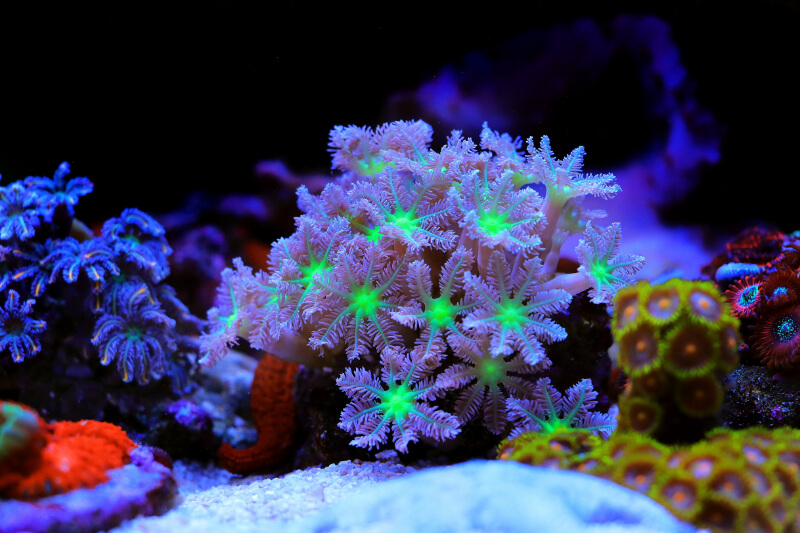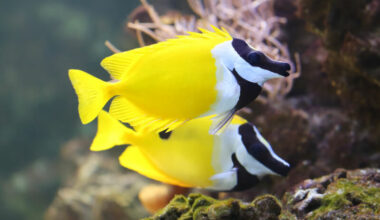Welcome, fellow saltwater aquarists, to our comprehensive care guide for the delightful Clove Polyps! These colorful organisms feature vibrant shades of colors creating a stunning visual spectacle within your aquarium.
As pet owners we are always looking for ways not only to make spaces visually attractive, but also entertaining to our fish and what better way than to add soft corals. They are affordable and maintenance is not too difficult as long as you are aware of a few things like preventing growth in unwanted areas. Ready to learn? Let’s dive in!
Table of Contents
Species Summary
The Clove Polyps is a soft coral with many common names, including the Fern polyps, Palm tree polyps and Eight tentacle polyps. Clavularia spp is the scientific name of this coral, and it belongs to the Clavulariidae family. This coral can be found on reefs in the Indo-Pacific, with one species in the Atlantic.
These corals are sometimes confused with the Blue Clove Polyps because of the similar name, which is a coral that takes over the entire tank. Unlike the Blue Clove Polyps, these corals only grow where there is a hard surface.
Appearance
The feathery tentacles create a flowery appearance, making it hard to miss the Clove Polyps. In fact, it looks to be dancing inside the tank as it sways in the current. Some species have eight thinner tentacles, and they are still a beautiful addition to your aquarium.
Clove Polyps can be found in green, purple, orange, yellow, white, cream and brown. The center of some corals is lighter than the ends of their tentacles, and some corals feature multiple colors that make aquarists think of a rainbow. On the other hand, some corals only feature a single solid color.

Lifespan
A soft coral colony has a shorter life expectancy than reefs that began growing centuries ago. In some cases, your Clove Polyps Coral may only have a lifespan of about 10 years. Nevertheless, proper care can help you get the most out of your Clove Polyps’ lifespan.
Average Size
The average size of a Clove Polyp is 2 inches to 3 inches, while its head only grows up to 0.5 inches to 0.75 inches.
Clove Polyps Care
It is easy to take care of Clove Polyps, which makes this coral a great addition to a starter tank. However, you still need to ensure you are providing these corals with the quality care they deserve, especially if you are placing them in a tank with other corals and fish species.
Tank Size
A colony of these soft corals can be contained on a rock island. When you also consider its small size, you have more choices when choosing a tank. You can place your Clove Polyps in a 10-gallon tank at minimum since this is the perfect size if you are looking to start a nano aquarium.
Water Parameters
When placing your Clove Polyps in their saltwater tank, you want to keep the water flow at moderate to high to nourish and clean your corals. One idea is to start your corals on moderate flow. You can stay at that level or increase the flow if you notice dancing corals and a clean base. If you notice their tentacles retracting, the water flow is too high.
When creating the right water parameters, you also want to consider elements such as water temperature and hardness.
Water temperature: 76-81 degrees Fahrenheit (24.4-27.2 degrees Celsius)
pH levels: 2-8.4
Water hardness: 8-11dKH (make sure it is stable within 0.5dkH)
Specific gravity: 1.023-1.025
Tank Setup
The Clove Polyps do well in the lighting of 50 to 100 PAR (Photosynthetically Active Radiation). They should receive around eight to 10 hours of full light and two to four hours of turning the light up and down. If you need to ramp up the lighting for any reason, it is essential to give your coral time to adjust to a different environment.
Additionally, it is vital to use care when adding Nitrates and Phosphates. While the nutrients of these elements increase their growth and coloration, you may also slow down their growth and coloration by adding too many of these elements. It is recommended to stick with Nitrate levels of one to 10 ppm and Phosphate levels of 0.01 to 0.05 ppm.
As for the tank itself, Clove Polyps spread to any hard surface as they grow, and this includes rocks that are already occupied by other corals. It is easier to prevent this issue than to remove the corals from those rocks. When setting up your tank, use at least 4 inches of fine-grained sand to separate their rocks from the rest of your aquarium.
Author Note: Corals cannot attach themselves to fine-grain sand, so you do not have to worry about them taking over your tank. It is vital to avoid coral rubble because your Clove Polyps may attach to the bits of gravel.
Are Clove Polyps Reef-Safe?
Yes, Clove Polyps are reef-safe corals and fun additions to your reef aquarium. As mentioned earlier, Clove Polyps are found on reefs in the wild.
Common Possible Diseases & Prevention
In addition to slowing growth and coloration, too many Nitrates and Phosphates can lead to unhappy, retracted and eventually dead Clove Polyps corals. You can prevent issues by sticking to the Nitrate and Phosphate levels shared earlier, but to be more specific, you want to keep the Phosphate levels closer to 0.1 ppm. Phosphate causes more problems for these soft corals than Nitrates, and you never want to find your corals permanently retracted.
Furthermore, corals need clean, warm water to survive, and water pollution must be prevented in their aquarium. In fact, too much debris can cause a lack of food by blocking out the sun, which results in dying corals. Prevention includes sticking to a temperature of at least 76 degrees Fahrenheit and keeping the tank clean.
Food & Diet
Clove Polyps enjoy a diet of zooxanthellae, microfauna and phytoplankton, which they capture with their tentacles. These foods provide the nutrients your corals need to thrive and survive.
While some aquarists do not bother with target feeding, you do not have to rule out this method altogether. As long as you watch the Nitrate and Phosphate levels, this is a great way to add more nutrients to their diet.
Author Note: You can offer the liquid from thawed rotifers, krill or mysis shrimp to provide your corals with proteins. Other options include Oyster-Feast, Marine Snow, Cyclops, and Roti-Feast. Otherwise, the zooxanthellae, microfauna and phytoplankton are good enough for your corals.
Behavior & Temperament
Clove Polyps are peaceful corals for the most part because they do not attack other species. However, they can also be semi-aggressive because they do not hesitate to grow over other corals. This is why it is recommended to keep their rock island separated from other hard surfaces.
While these corals do not sting, they may be the victim of other corals stinging and damaging them. This can lead to your Clove Polyps losing their heads and dying from toxins, so it is important to keep them away from more aggressive corals.

Clove Polyps Tank Mates
When spaced out properly, the Clove Polyps do not bother other corals. They also do not bother other fish in the tank, but they may hide from sight if they feel threatened. These corals also produce a chemical that tastes horrible to reef-nibbling fish, which is another way of protecting themselves against predators.
Despite their behavior when growing or feeling threatened, these soft corals can make peaceful tank mates. The best tank mates for Clove Polyps are those fish without jaws and teeth suitable for biting algae which include the following species.
- Some wrasses like the Red Coris Wrasse but be careful because they may inadvertently damage them when moving nearby rocks and structures
- Dogface puffer
- Dartfishes
- Domino damselfish
- Gobies (we love the Mandarin Goby)
- Seahorses
- Grammas like the Royal Gramma
If you want to add other soft corals to your aquarium, you are safe with the following tankmates.
- Green star polyp
- Kenyan tree coral
- Kenyan tree coral
There are some fish that eat soft corals so be careful with the following guys:
- Angelfishes like the Emperor Angelfish
- Puffers
- Triggerfishes so don’t try the Clown Triggerfish
- Boxfishes
Breeding
There are several methods of breeding the Clove Polyps, from providing a hard surface to letting nature take its course.
Placing a piece of rock or shell on the edge of the colony is the easiest way to breed your Clove Polyps. In fact, you can never go wrong with this method because the colony’s edge is a popular budding spot. Your corals grow over the structure, allowing new corals to bud and settle on their surface. Once the corals grow, you can cut and move the segment as desired.
While this method requires a lot of time and patience, it is easier than fragging. To frag a soft coral, use a razor blade to cut through the Stolon of the colony. Remove as much water as you can by blotting the cut area, and attach the frag in a new spot.
Author Note: Fragging is a quicker method of breeding, but it is best to stick with the method of providing a new surface if you do not have much experience with fragging soft corals
Producing planula larvae on the colony’s surface is another way Clove Polyps breed. The planulae drift with the current, allowing them to settle and metamorphose. A new colony starts when the planulae build up Calyx and Stolon. It is a slow process, but it is worth it to see the start of a new coral colony.
Wrapping Up
We hope this care guide has provided valuable insights into the enchanting world of Clove Polyps, those vibrant additions to your saltwater aquarium. Their unique nature as soft corals offers a striking alternative to traditional reef structures, adding a splash of color and diversity to your underwater oasis.
Creating a stable environment with appropriate lighting, water flow, and proper feeding will ensure their health and vitality. Don’t forget to create a no-growing-allowed-zone to prevent spreading to unwanted areas.
If you are looking for more knowledge feel free to check our other saltwater care guides and maybe even tag us on Facebook when posting a cool photo of your aquarium.
Thanks for visiting and happy reef-keeping!

